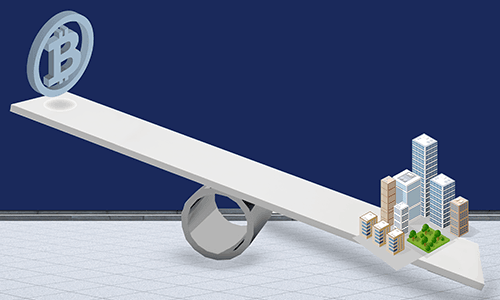
Crypto vs Fractional Ownership: The Investment Debate
3 Feb, 2022
Last year was a rude awakening and gave us a stern lesson on the importance of stability. If retrenchments and salary cuts didn’t fray the nerves, the sudden closure of six debt mutual fund schemes last April certainly scarred the psyche of the cautious investor.
And if fixed deposits were considered a safe haven, the paltry interest rates didn’t help matters. In fact, the Covid-19 crisis pushed down the FD rates to their lowest in a decade. From 9.5% in 2011 and 7% in 2019, the current return rates are hovering around the 5.5%-mark. After tax, the net return is under 4%, which is less than the country’s 10-year inflation rate. Simply put, FD investment is actually weakening your spending power in the long run! Unsurprisingly, risk-averse investors have been looking for a viable and attractive safe investment in a low-interest regime.
Enter Fractional Ownership in Commercial Properties. This new-age investment is gaining steam because it allows small investors to put affordable sums in India’s booming, but hitherto expensive, commercial real estate market. Widely popular in the US, Europe, and Japan, fractional ownership (FA) is expected to grow to $5 billion in India in the next three years. The reason behind this is It’s democratizing the commercial property market by lowering the high entry barrier and high capital investment. Not to be confused with REITs, which are publicly listed and their pricing is subject to stock market volatility, fractional ownership (FA) is a traditional property investment.
Imagine an Rs 50 crore commercial property. Typically, such a property would only be accessible to high-net-worth individuals (HNIs). But fractional ownership allows you to invest as little as Rs 25 lakh and be a part-owner of the property.
Rental Yield Adds Resiliency
The fractional ownership model mainly focuses on Grade A commercial properties. These are the highest-quality office spaces that are recently constructed and equipped with top-of-the-line fixtures, amenities, etc. As a result, such properties charge a premium over the average rent in the vicinity.
By investing through fractional ownership, one can enjoy rental returns between 8% to 12% per annum. This means that a Rs 25 lakh investment can fetch you returns of Rs 2-3 lakh every year, which is significantly higher compared to traditionally safer investments such as fixed deposits and debt funds. Compare it with residential properties, the same investment would give you Rs 50,000 to 85,000 return at best in a post-Covid world. As for gold, it has sharply fallen from a high of Rs 57,400 in August 2020 to Rs 47,900 in April 2021.
Further, fractional ownership in commercial real estate offers stability because Grade A properties are usually leased out for a minimum of 5 years by some of the biggest corporates in the country, especially by the IT/ITes sector that typically enjoys healthy free cash flow due to their low capital-intensive business. Hence, this guarantees you constant rental returns every month.
Potential for High Capital Appreciation
Commercial property investments have provided a 16% CAGR in the last five years. The future looks decidedly brighter due to robust occupier interest in traditional offices, co-working spaces, and flexible spaces.
As per a Colliers International report, the leasing activity in the sector has grown at 12% CAGR in the last three years. Last year alone, despite the upheaval, the net absorption of commercial space stood at 25 million square feet. This year, the number is expected to breach the 30-million mark. In addition, the rentals are typically renegotiated every three years and can rise by as much as 15%, which can help you keep pace with the inflationary rate in the country and deliver you higher returns than other low-risk investments.
Weathering the WFH Factor
Offices still remain intact. While the ongoing pandemic has upended the traditional playbook by introducing work-from-home, better VPNs, and video-conferencing tools, these measures are not sustainable for most businesses over the long term. This is primarily due to data security, psychological impact on employees, and monitoring productivity.

